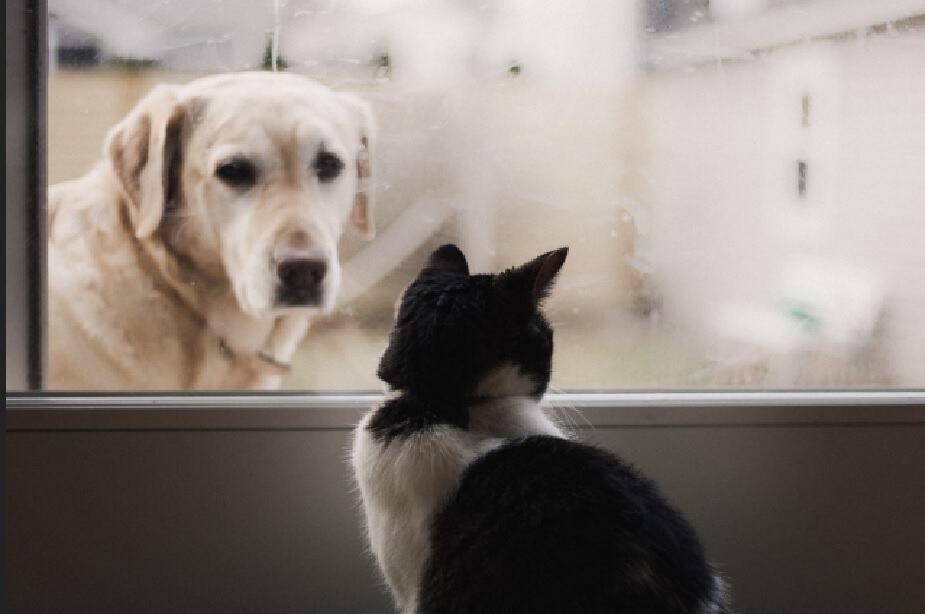
Dogs and cats can be like oil and vinegar. Many families looking to buy a hunting dog already have a pet cat. Likely there is trepidation in introducing a hunting dog into household with a cat. Before getting a hunting dog, pet owners might want to know: can a hunting dog live with cats?
Yes, hunting dogs can live with cats. Many believe dogs bred for hunting, especially those bred for hunting furred animals, will treat cats like a game animal and attempt to harm or kill them. Individual dogs may have an aversion to cats, but the blanket statement that hunting dogs cannot live with cats is false. Many hunting dog owner also own cats and it’s not uncommon to see the two living without incident. While some hunting dog breeds bred to hunt furred animals may be more likely to have trouble living with cats, individual dog temperament, environment and training will play a larger factor in the success of any dog and cat living peacefully together.
Knowing its possible that hunting dogs can live with cats the next thing you might be wondering is how to introduce the two.
16 Tips for Introducing a Hunting Dog to Cats
- Have control over the environment and situation. Make sure you can stop a possible attack during the introduction of the dog and cat.
- Seek help from a professional dog trainer in your area.
- During the introduction give the cat room to have its own space and escape if needed. The cat will be more likely to relax if it knows it is not trapped and can freely leave if it is uncomfortable.
- If the space is new, let the dog explore it first and get comfortable before introducing the cat. Introducing the new space and the new cat at the same time might be too much change at once for the dog which will raise the dog’s anxiety level. For the best results, you want the dog as calm as possible when meeting the cat.
- Check your energy level and body language. Make sure you are relaxed; animals will read your body language and react to it. If you are tense or on edge the dog will read your tension and may associate that tension with the cat and react negatively.
- Watch the dog and cat’s body language. Break up the two before the situation escalates. Try reintroducing the animals when they both settle down.
- Introduce the dog to a cat that a dog friendly cat first before introducing the dog to a cat that is not dog friendly or is new to dogs. If you have a friend with a cat that already lives with dogs or is accustom to them try introducing your dog to that cat in a controlled situation first before introducing your dog to a cat that is unfamiliar with dogs.
- Use a leash, gate or crate to restrain the dog during initial introductions until both animals are calm around each other. Make sure the dog can be calm on a leash or in a crate before the introduction, if that is your method of restraining the dog. Do not add extra stress to the introduction by using a method of restraint that will stress the dog.
- Spread controlled introductions over days to slowly let the animals get accustomed to each other.
- Exercise the dog before meeting the cat and get the dog good and worn out. This will decrease the dog’s energy level and make the dog more likely to be calm during the introduction. Getting the dog a good long run, swim or play session followed by some time to calm down would be a good pre-introduction option.
- Don’t make the introduction around food. Some animals get aggressive or competitive around food. Best not to introduce this extra agitation during initial introductions.
- Don’t let either animal feel or get cornered. Make sure both animals feel like they have their own space and places to retreat to. This will decrease the stress level of the animals.
- Don’t leave the animals unsupervised. This should go without saying. But until you are totally confident there wont be a problem only let the animals around each other under supervision.
- Don’t let the animals fight, bark, scratch, bite, swipe, growl, or make aggressive or negative actions toward each other. Some might suggest letting the cat “correct” the dog. However, this could lead to an escalation. Better if you see any of these actions or it is heading in that direction, that you be the one to do the “correcting” or simply separate the animals and try another introduction later when the situation has settled down.
- Don’t introduce multiple animals at a time. Keep it to one cat and one dog. If you have multiple cats and/or dogs you need to introduce, better to start with just one on one at first.
- Don’t introduce a dog to its first cat if the cat has had problems with dogs before. If the cat has a problem with dogs and acts aggressively toward the dog, it could negatively impact the dog’s interactions with all cats in the future.
Helpful Tips for Hunting Dogs to Successfully Live with Cats
After successful introductions between cats and hunting dogs, these tips will help insure a continued happy shared home between the two.
- Designate a dog free space for the cat. This is a location in the house that the dog is not allowed to go, that the cat can use to get away from the dog, relax and have its own space.
- Enforce good obedience. Work with the dog to insure it is predictably complying with commands you give it. Reinforce commands equivalent to “stay”, “no”, “leave it”. This will insure you have a way to tell the dog when the cat has had enough and should be left alone.
- Protect the litter box from the dog. Some dogs have a nasty habit of using the litter box as a snack cupboard, which obviously should be dissuaded. Giving the cat a safe space to use the litter box will also keep it from using other locations to do its business.
- Get the dog plenty of exercise every day. A dog that has been exercised properly is better behaved. An exercised dog is less likely to spend that energy tormenting the cat or getting itself into other trouble out of boredom.
Hunting Dog Breeds that are Better with Cats
Hunting dog breeds that are used for hunting birds may be a better choice for living with cats than those bred to hunt furred animals. Retrievers, Labs, Spaniels, English Pointers, Brittanys and English Setters were primarily bred for hunting birds. While each individual dog is different, these breeds will have less bred in drive to hunt furred animals.
Terriers, hounds, and many German breeds of hunting dogs are bred to chase, trail, catch or tree furred game animals such as rabbits, mountain lions, deer, foxes, woodchucks, badgers, and bears. These breeds may be more prone to dislike of cats. However, I wouldn’t scratch these dogs off your list if you are looking for a hunting breed. Temperament will very from dog to dog and will be impacted by environment and training. While these breeds might be more likely to dislike cats its doesn’t mean every dog of each breed will.
Don’t Risk It, Seek Help from a Professional
A lot of what is here is just tips and suggestions. If you have any concerns about introducing your dog to cats, or your cat to a hunting dog; get professional help from a dog trainer. It is always better to be safe than sorry.
